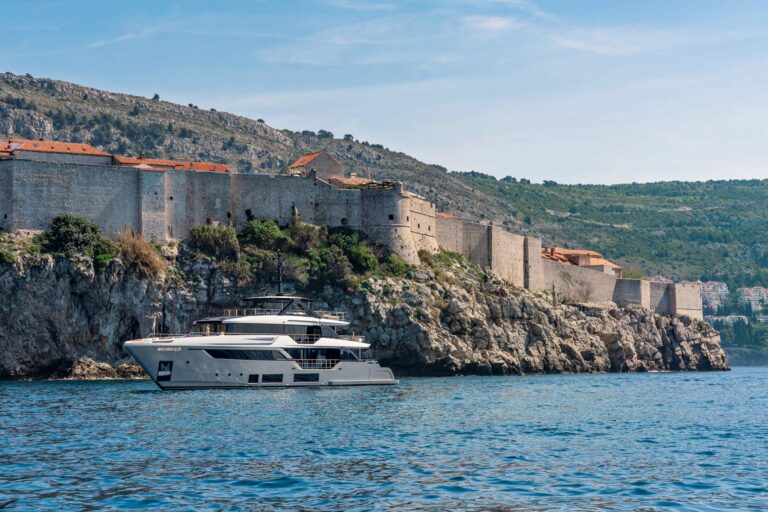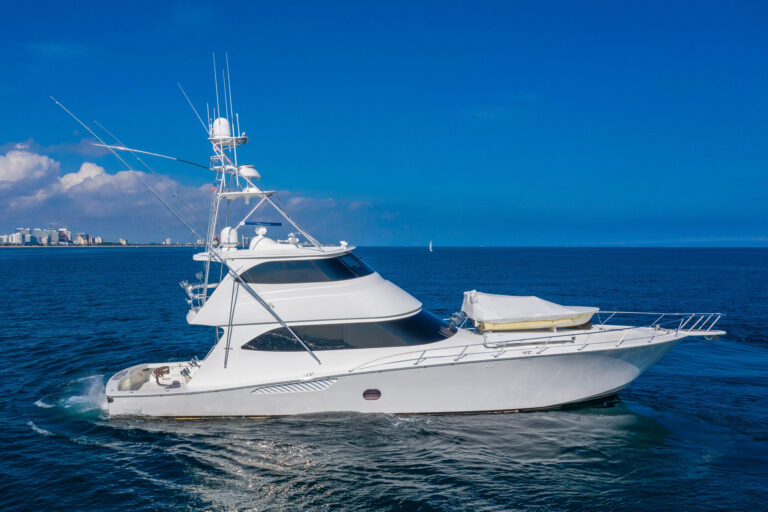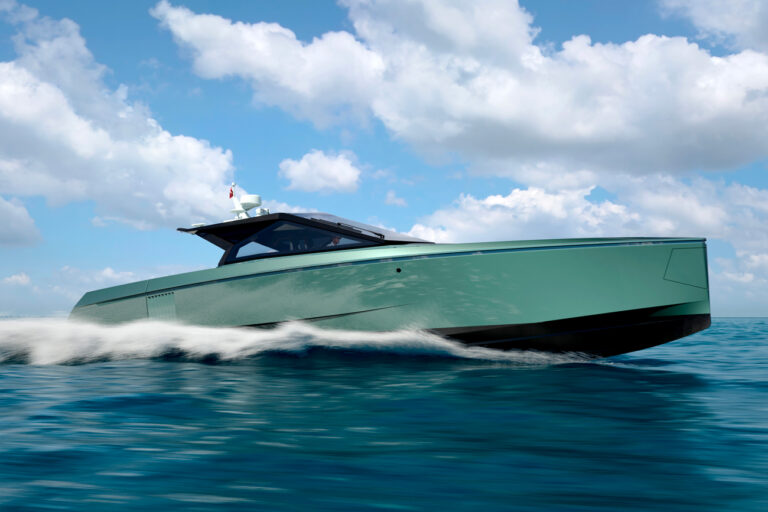Blue Star’s Grove Ely called me more than a year ago, bubbling with enthusiasm about his latest collaboration with naval architect Mark Ellis. At first, my enthusiasm was mellowed by the thought of another traditional express cruiser in what could be labeled an overcrowded market.
After looking at the drawings, I became as giddy as Ely. The rendering of the Blue Star 36.6 was not just a regurgitated concept with a few clever features. Ely had incorporated ideas and details stemming from his boating experience and three-plus decades in the yacht sales and service business.
One of the most refreshing things about the Blue Star, compared with other models in her class, is the arrangement plan. It blends the openness of an express cruiser with the accommodations and finish of a fully enclosed sedan.
“I came up with this after cruising the waterway on our Eastbay 43, Ely said. (Ely’s company, Boatworks Yacht Sales, is the largest dealer for that series.) He found that he rarely ran the boat from the upper station. Instead, he and his wife enjoyed the lower station and the comforts of the saloon. Moreover, they enjoyed the openness afforded by the 43’s galley-down arrangement, keeping the helmsman in touch with the cook and avoiding the “tunnel feeling aboard many express cruisers.
To construct the same feeling on the 36.6, Ely and Ellis designed the boat with no bulkhead between the helm deck and the lower accommodations, eliminating the overhead above the galley. The hardtop’s side and front windows expand to the fullest shape possible, providing fantastic visibility from every point on the helm deck. A clever convertible seat at the end of the portside settee allows a companion to sit at the adjacent navigation table and remain part of the action while under way.
I tested hull number one, which had a fixed, bench-style helm seat. The next launch will have a pedestal seat, which is my preference. Although a pedestal seat sacrifices some stowage, the 36.6 has more than enough lockers and deck stowage. Plus, a pedestal seat works well when it’s time for the skipper to turn and join the conversation at the portside L-shape settee and the straight settee abaft the helm.
Bruckmann Yachts finished the helm deck with a teak-and-holly sole and white Formica bulkheads accented by gloss teak joinery. The galley includes a two-burner propane stove, 12-volt refrigeration, a microwave and enough counter space to prepare a gourmet picnic. An opening hatch and port provide fresh breezes and ventilation while cooking. A traditional dinette, opposite, is a natural gathering place for guests while the cook is hard at work.
A queen island berth and wet head are forward. The gloss finish on the solid teak joinery exudes an air of elegance.
That elegance continues in the exterior styling. With the 36.6, Ellis fine-tuned the popular retro-style boat that crowded so many docks at Northeast boat shows this fall. Walking around this little yacht, I couldn’t find a harsh angle. This is not easy to accomplish on a 36-foot pocket yacht with a hardtop. The hardtop can often reveal itself as a misplaced hard hat.
A substantial overhang allows the Isinglass to remain open in the rain, and the vertical supports provide natural grab rails when boarding from a finger pier. Ellis drew a sweet camber on the top that reflects the forward trunk cabin, providing the look of one fluid line. A teak eyebrow around the cabin accents the perfectly proportioned caprail. Forward, bow lockers are camouflaged in the painted nonslip deck.
Still, don’t think this boat is some museum piece designed only to host champagne harbor cruises. I delivered hull number one 140 miles from the Newport International Boat Show to the Norwalk In-Water Boat Show on a blustery September morning. Because of time constraints, I didn’t have the benefit of waiting until the weather lay down. Turning the corner into Narragansett Bay, I met a few rollers streaming in with southwest winds. I throttled up the 370 hp Yanmar diesels and-boom-popped onto a plane. I glided over the top of the 3- to 4-foot rollers at 25 knots, with the forward chine and bow flare casting waves aside.
At Block Island Sound, I had to slow down. The seas grew to stacked 6- to 8-footers. An occasional larger wave shook the little yacht, but wind and water were getting a little extreme. I was able to maintain a speed between 15 and 17 knots while a few other yachts, including a 115-foot motoryacht, headed back for shelter.
The one disconcerting note is that the windshield frame shook when the boat fell off a few of the bigger seas. I brought this up with Clute Ely, vice president of Boatworks Yacht Sales, and he was aware of the problem. He said there were plans to “beef up the structure.
After about two hours in the rough seas, things smoothed down. In Long Island Sound, I cruised at 26.5 knots at 2800 rpm. The 36.6 planed without effort from a standstill, as if she were agitated that I had placed her in idle while eating my lunch.
Checking the engines and systems before my departure was not a problem thanks to the slender Yanmars, the boat’s 13-foot, 2-inch beam, and the good use of engineroom space. Adding a generator would make things a little tighter, though.
When I last saw the Blue Star at the Norwalk show, she was hosting not only a flock of interested customers, but also a few curious boatbuilders speaking kind words. One builder planned to incorporate some of the Blue Star’s features, at Ely’s urging.
I can’t think of a better compliment, or better proof that the Blue Star 36.6 truly offers something different in this saturated niche. Boatworks Yacht Sales, (203) 866-0882; www.boatworksyachtsales.com.









